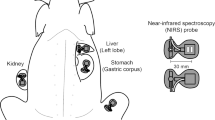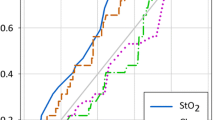Abstract
Purpose
To examine the consequences of administration of norepinephrine on muscle tissue oxygenation in severely hypotensive septic shock patients.
Methods
This was a prospective observational study conducted in a medical intensive care unit of a university hospital. We included 28 septic shock patients that received early volume resuscitation. All were eligible for receiving norepinephrine because of life-threatening hypotension and low diastolic arterial pressure. Muscle tissue oxygen saturation (StO2) and its changes during a vascular occlusion test were measured at the level of the thenar eminence using a near-infrared spectroscopy (NIRS) device. Transpulmonary thermodilution cardiac index (CI) and NIRS-derived variables were obtained before and after the mean arterial pressure (MAP) was increased by norepinephrine. The baseline StO2 and the vascular occlusion test-derived variables of 17 healthy volunteers were measured and served as controls.
Results
In healthy volunteers, StO2 ranged between 75 and 90% and StO2 recovery slopes ranged between 1.5 and 3.4%/s. Administration of norepinephrine, which was associated with an increase in MAP from 54 ± 8 to 77 ± 9 mmHg (p < 0.05), also induced increases in CI from 3.14 ± 1.03 to 3.61 ± 1.28 L/min/m2 (p < 0.05), in StO2 from 75 ± 9 to 78 ± 9% (p < 0.05) and in StO2 recovery slope from 1.0 ± 0.6 to 1.5 ± 0.7%/s (p < 0.05).
Conclusions
Norepinephrine administration aimed at achieving a MAP higher than 65 mmHg in septic shock patients with life-threatening hypotension resulted in improvement of NIRS variables measured at the level of the thenar eminence.




Similar content being viewed by others
References
Ince C (2005) The microcirculation is the motor of sepsis. Crit Care 9(Suppl 4):S13–S19
Vincent JL, De Backer D (2005) Microvascular dysfunction as a cause of organ dysfunction in severe sepsis. Crit Care 9(Suppl 4):S9–S12
Trzeciak S, Cinel I, Dellinger RP, Shapiro NI, Arnold RC, Parrillo JE, Hollenberg SM, Microcirculatory Alterations in Resuscitation and Shock (MARS) Investigators (2008) Resuscitating the microcirculation in sepsis: the central role of nitric oxide, emerging concepts for novel therapies, and challenges for clinical trials. Acad Emerg Med 15:399–413
De Backer D, Creteur J, Preiser JC, Dubois MJ, Vincent JL (2002) Microvascular blood flow is altered in patients with sepsis. Am J Respir Crit Care Med 166:98–104
Ellis CG, Jagger J, Sharpe M (2005) The microcirculation as a functional system. Crit Care 9(Suppl 4):S3–S8
Ellis CG, Bateman RM, Sharpe MD, Sibbald WJ, Gill R (2002) Effect of a maldistribution of microvascular blood flow on capillary O2 extraction in sepsis. Am J Physiol Heart Circ Physiol 282:H156–H164
Vallet B (2003) Bench-to-bedside review: endothelial cell dysfunction in severe sepsis: a role in organ dysfunction? Crit Care 7:130–138
Hartl WH, Günther B, Inthorn D, Heberer G (1988) Reactive hyperemia in patients with septic conditions. Surgery 103:440–444
Neviere R, Mathieu D, Chagnon JL, Lebleu N, Millien JP, Wattel F (1996) Skeletal muscle microvascular blood flow and oxygen transport in patients with severe sepsis. Am J Respir Crit Care Med 153:191–195
Sibbald WJ, Fox G, Martin C (1991) Abnormalities of vascular reactivity in the sepsis syndrome. Chest 100:155S–159S
Vallet B (1998) Vascular reactivity and tissue oxygenation. Intensive Care Med 24:3–11
Dellinger RP, Levy MM, Carlet JM, Bion J, Parker MM, Jaeschke R, Reinhart K, Angus DC, Brun-Buisson C, Beale R, Calandra T, Dhainaut JG, Gerlach H, Harvey M, Marini J, Marshall J, Ranieri M, Ramsay G, Sevransky J, Thompson BT, Townsend S, Vender JS, Zimmerman JL, Vincent JL (2008) Surviving Sepsis Campaign guidelines for management of severe sepsis and septic shock: 2008. Intensive Care Med 34:17–60
Ward KR, Ivatury RR, Barbee RW, Terner J, Pittman R, Filho IP, Spiess B (2006) Near infrared spectroscopy for evaluation of the trauma patient: a technology review. Resuscitation 68:27–44
De Blasi RA, Palmisani S, Alampi D, Mercieri M, Romano R, Collini S, Pinto G (2005) Microvascular dysfunction and skeletal muscle oxygenation assessed by phase-modulation near-infrared spectroscopy in patients with septic shock. Intensive Care Med 31:1661–1668
Pareznik R, Knezevic R, Voga G, Podbregar M (2006) Changes in muscle tissue oxygenation during stagnant ischemia in septic patients. Intensive Care Med 32:87–92
Skarda DE, Mulier KE, Myers DE, Taylor JH, Beilman GJ (2007) Dynamic near-infrared spectroscopy measurements in patients with severe sepsis. Shock 27:348–353
Creteur J, Carollo T, Soldati G, Buchele G, De Backer D, Vincent JL (2007) The prognostic value of muscle StO2 in septic patients. Intensive Care Med 33:1549–1556
Pottecher T, Calvat S, Dupont H, Durand-Gasselin J, Gerbeaux P, SFAR/SRLF workgroup (2006) Hemodynamic management of severe sepsis: recommendations of the French Intensive Care’ Societies (SFAR/SRLF) Consensus Conference, 13 October 2005, Paris, France. Crit Care 10:311
Moens AL, Goovaerts I, Claeys MJ, Vrints CJ (2005) Flow-mediated vasodilation: a diagnostic instrument, or an experimental tool? Chest 127:2254–2263
Doerschug KC, Delsing AS, Schmidt GA, Haynes WG (2007) Impairments in microvascular reactivity are related to organ failure in human sepsis. Am J Physiol Heart Circ Physiol 293:H1065–H1071
Podbregar M, Mozina H (2007) Skeletal muscle oxygen saturation does not estimate mixed venous oxygen saturation in patients with severe left heart failure and additional severe sepsis or septic shock. Crit Care 11:R6
Mesquida J, Masip J, Gili G, Artigas A, Baigorri F (2009) Thenar oxygen saturation measured by near infrared spectroscopy as a noninvasive predictor of low central venous oxygen saturation in septic patients. Intensive Care Med 35:1106–1109
Leone M, Blidi S, Antonini F, Meyssignac B, Bordon S, Garcin F, Charvet A, Blasco V, Albanèse J, Martin C (2009) Oxygen tissue saturation is lower in nonsurvivors than in survivors after early resuscitation of septic shock. Anesthesiology 111:366–371
Dubin A, Pozo MO, Casabella CA, Palizas F Jr, Murias G, Moseinco MC, Kanoore Edul VS, Palizas F, Estenssoro E, Ince C (2009) Increasing arterial blood pressure with norepinephrine does not improve microcirculatory blood flow: a prospective study. Crit Care 13:R92
Jhanji S, Stirling S, Patel N, Cj Hinds, Pearse RM (2009) The effect of increasing doses of norepinephrine on tissue oxygenation and microvascular flow in patients with septic shock. Crit Care Med 37:1961–1966
Draisma A, Bemelmans R, Van der Hoeven JG, Spronk P, Pickkers P (2009) Microcirculation and vascular reactivity during endotoxemia and endotoxin tolerance in humans. Shock 31:581–585
Sakr Y, Dubois MJ, De Backer D, Creteur J, Vincent JL (2004) Persistent microcirculatory alterations are associated with organ failure and death in patients with septic shock. Crit Care Med 32:1825–1831
Boerma EC, van der Voort PHJ, Spronk PE, Ince C (2007) Relationship between sublingual and intestinal microcirculatory perfusion in patients with abdominal sepsis. Crit Care Med 35:1055–1060
Trzeciak S, Dellinger RP, Parrillo JE, Guglielmi M, Bajaj J, Abate NL, Arnold RC, Collila Z, Zanotti S, Hollenberg SM, Microcirculatory Alterations in Resuscitation and Shock (MARS) Investigators (2007) Early Microcirculatory perfusion derangements in patients with severe sepsis and septic shock: relationship to hemodynamics, oxygen transport, and survival. Ann Emerg Med 49:88–98
Buchele GL, Ospina-Tacone GA, De Backer D (2007) How microcirculation data have changed my clinical practice. Curr Opin Crit Care 13:324–331
Degens H (1998) Age-related changes in the microcirculation of skeletal muscle. Adv Exp Med Biol 454:343–348
Hammer LW, Boegehold MA (2005) Functional hyperemia is reduced in skeletal muscle of aged rats. Microcirculation 12:517–526
Boerma EC, Kuiper MA, Kingma WP, Egbers PH, Gerritsen RT, Ince C (2008) Disparity between skin perfusion and sublingual microcirculatory alterations in severe sepsis and septic shock: a prospective observational study. Intensive Care Med 34:1294–1298
Author information
Authors and Affiliations
Corresponding author
Additional information
Jean-Louis Teboul is a member of the medical advisory board of Pulsion.
Electronic supplementary material
Below is the link to the electronic supplementary material.
Rights and permissions
About this article
Cite this article
Georger, JF., Hamzaoui, O., Chaari, A. et al. Restoring arterial pressure with norepinephrine improves muscle tissue oxygenation assessed by near-infrared spectroscopy in severely hypotensive septic patients. Intensive Care Med 36, 1882–1889 (2010). https://doi.org/10.1007/s00134-010-2013-3
Received:
Accepted:
Published:
Issue Date:
DOI: https://doi.org/10.1007/s00134-010-2013-3




